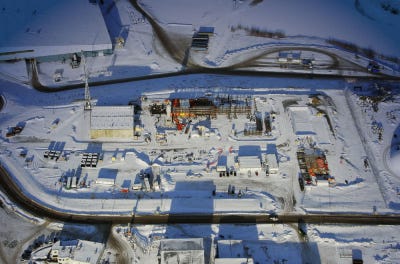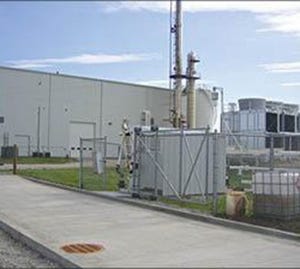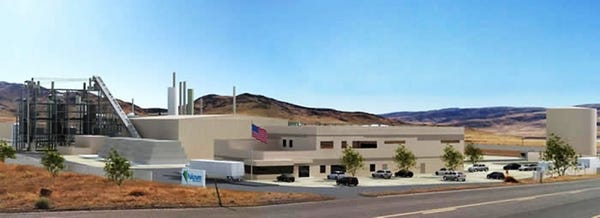Preaching Conversion
Though it has long held great promise, waste conversion in the United States has so far failed to become a viable waste management option.
In summarizing the state of waste conversion technologies it would be fair to say that while there’s been a good amount of sizzle, the steak remains elusive. For while this “waste-to-energy on steroids” option has generated a lot of interest and numerous attempted projects, so far there haven’t been any successful commercial ventures in North America.
 The technologies, which include gasification, pyrolysis and plasma arc, have the potential to yield a higher-end product than traditional waste to energy (WTE), or mass burn, as well as refuse-derived fuel (RFD). While air is required for mass burn, conversion methods can operate without air, relying only on the oxygen in the waste itself — as in pyrolysis — or partial controlled air, as in gasification. The waste is converted into a gas and then the gas is made into an energy product such as ethanol, a liquid fuel or biodiesel gas, says Harvey Gershman, president of the Fairfax, Va.-based solid waste management consulting firm Gershman, Brickner & Bratton Inc. (GBB). “It’s more of a chemical process going on than ‘just add air, burn it, heat release.’”
The technologies, which include gasification, pyrolysis and plasma arc, have the potential to yield a higher-end product than traditional waste to energy (WTE), or mass burn, as well as refuse-derived fuel (RFD). While air is required for mass burn, conversion methods can operate without air, relying only on the oxygen in the waste itself — as in pyrolysis — or partial controlled air, as in gasification. The waste is converted into a gas and then the gas is made into an energy product such as ethanol, a liquid fuel or biodiesel gas, says Harvey Gershman, president of the Fairfax, Va.-based solid waste management consulting firm Gershman, Brickner & Bratton Inc. (GBB). “It’s more of a chemical process going on than ‘just add air, burn it, heat release.’”
The biggest potential advantage to waste conversion, Gershman says, is the opportunity to make a higher-value fuel. “Some conversion technologies are going to power, but the ones that I think have the greatest economic potential are the ones that are going to make a higher value product like ethanol.” A company can make 60 gallons of ethanol from a ton of garbage with a value of approximately $3 a gallon for $180 a ton, says Gershman, compared with something more like $36 in revenue from a ton by converting it to electricity. “That’s a huge value proposition, and that’s what people are trying to do: make something more valuable,” he says.
Not only can the product from waste conversion be more valuable but it lends itself to a wider range of products, says Bryan Staley, president of the Raleigh, N.C.-based Environmental Research & Education Foundation. “Diesel, gasoline, olefins, waxes — lots of beneficial products can come from this. With other technologies you can get a limited number of projects.”
And the transformation can happen more quickly than traditional landfill gas-to-energy (LFGTE) projects, which require long waits for waste to decompose in order to generate methane.
In addition to the economic benefits, Gershman adds, waste conversion keeps the waste out of the landfill and creates less volume, because little or no air is added in the process.
Houston-based Waste Management Inc. has been an active player in waste conversion technology development, even ranking on Biofuels Digest’s list of the “50 Hottest Companies in Bioenergy.” The company, which declined to speak for this article, has helped fund Montreal-based Enerkem Inc.’s waste-to-biofuels facility being built in Edmonton, Alberta, and has been a partner with Pleasanton, Calif.-based Fulcrum BioEnergy Inc. on WTE projects, including Fulcrum’s Sierra BioFuels plant east of Reno in Storey County, Nev.
Scale Means Sales
So why hasn’t waste conversion become a more viable waste management option? One word: Scale. “The problem is these companies are not doing it on a large scale,” Gershman says. “So where they’re trying to implement plans they’re trying to work out who bears the risk if the thing doesn’t work, where’s the waste come from, all these implementation issues. When you have an unproven technology, these are issues that get hard to deal with.”
What waste conversion companies need is an investor to provide them with funding. “A lot of these companies are small developers that don’t even have a balance sheet,” he says.
“So when you have a new company with a new technology it’s much different than implementing a proven technology with a proven company. That’s why some of these projects are coming out slow or not at all.”
Staley says the other big issue besides scale is contaminants, such as metals and other inert materials. “Many companies neglect the cost of preprocessing the material before it goes into the technology.”
Some materials work well in conversion with a high-moisture content, and some do not. Gasification typically needs less than 10-percent moisture content, and with mixed waste composed of 20 to 30 percent moisture, Staley says, that can be a problem. “A couple companies doing waste conversion have said they have enough heat to dry it out – they think it’s easy to do. It’s not trivial. It could mean substantial front-end costs.”
Ineos Bio, a Swiss firm with U.S. headquarters in Lisle, Ill., has the waste conversion project closest to commercialization in the United States, in Vero Beach, Fla. Working with the U.S. Environmental Protection Agency (EPA) has been a challenge for the company, says Dan Cummings, vice president and business manager, external affairs for the Americas and Asia. For example, EPA didn’t approve municipal solid waste (MSW) as a feedstock for producing fuel by conversion until after the Vero Beach plant was designed.
“The EPA has been slow to approve these new pathways for these waste conversion technologies,” Cummings says. “It’s difficult to convince investors that you’re going to get all your permits to operate and be able to sell the fuel into the market.”
Competing for Organics
Staley also has seen evidence that waste haulers invested in LFGTE projects perceive waste conversion as a competing technology. “They say, ‘why would we invest millions in a waste conversion technology and then pull the organics out of the landfill, when at a much lower cost we can keep them in landfill and pull electricity from the gas?’” It’s particularly an issue when the LFGTE operation has been in place for years and is starting to become profitable.
The economics of waste conversion can be challenging as well when tipping fees are $30 to $50 a ton.
 And finally, it’s a misnomer that you can get to zero waste with waste conversion. Staley says with gasification, for example, just 55.7 percent of waste materials can be used in the process. “The perception is that you can shovel all the the MSW into these technologies and you get this wonderful fuel. That’s not the case.”
And finally, it’s a misnomer that you can get to zero waste with waste conversion. Staley says with gasification, for example, just 55.7 percent of waste materials can be used in the process. “The perception is that you can shovel all the the MSW into these technologies and you get this wonderful fuel. That’s not the case.”
Part of the problem has been too much hyperbole about waste conversion, Staley says. While the hype has lessened somewhat, it remains. “The sales pitch was way out ahead of where technology really was, and I think that’s still true today. People are writing checks they really can’t cash.”
The projects emerge and disappear. In Ada County, Idaho, a conversion project evaporated when a deal involving the sole funding source and elected officials fell through. In Lake County, Ind,, the developer decided he couldn’t make it happen at the end of the day, Gershman says.
The Enerkem biofuels plant in Edmonton currently being constructed gives waste conversion advocates hope, but the project that many are watching is the Ineos Vero Beach operation, which the company expects to be the first commercial-scale cellulosic ethanol from waste facility in the United States.
The facility began producing renewable power last September, and it is moving into its final start-up phase with the goal of ethanol production, Cummings says. The facility will process 300,000 tons a year from primarily vegetative, yard and agricultural waste. At full capacity it will produce 8 million gallons of ethanol and six megawatts of renewable power annually. It’s a fully integrated gas fermentation technology that converts waste into a syngas that goes into a bioreactor and comes out as a mixture of ethanol and water that is distilled and dried, or can be further purified and used as a pharmaceutical grade alcohol as well.
 Ineos has agreements in place with Indian River County where Vero Beach is located and others to supply the waste needed to fuel the plant. The facility is located next to a landfill, and Cummings says the facility also is using that gas to generate renewable power. Ineos hopes to build more plants once the Vero Beach facility is successful.
Ineos has agreements in place with Indian River County where Vero Beach is located and others to supply the waste needed to fuel the plant. The facility is located next to a landfill, and Cummings says the facility also is using that gas to generate renewable power. Ineos hopes to build more plants once the Vero Beach facility is successful.
Cummings says the difference for the Vero Beach project is Ineos’ size. It claims to be the fourth largest chemical company in the world, and it’s using a technology that it has already commercialized. “We can take that technology to the next level in the commercialization phase.”
Still, it was a challenge scaling up from a pilot-scale facility. The transition was made somewhat smoother because Ineos has gotten a lot of support from the federal government, aided by its past success.
Cummings says the Vero Beach waste conversion project also is appealing to the firm because infrastructure already is in place to collect and process the waste, as opposed to using agriculture or crop waste. In addition, Ineos had the advantage of having a conversion facility that can accept single-stream waste, which makes it easier for a municipality.
“We see this effort as a complement to the recycling effort,” Cummings says. “We’re looking to help the recovery and conversion of that carbon material into another useful product, primarily fuel and power.”
Conversion Crossroads
Some conversion projects are trying different strategies. Staley says Davis, Calif.-based Sierra Energy Corp. has a conversion plant that processes 20 tons a day but the company’s plans involve multiple facilities, so that’s one way to get up to scale of say 100 tons.
Then there are government mandates. North Carolina has set a goal that of all fuel consumed in the state, 10 percent needs to come from state-generated biofuels. EREF is working on a project through the state’s Biofuel Center that’s benefiting from that goal.
 GBB is working on a project with Virginia’s Prince William County in which the county has invited an emerging technologies company to build a 100-ton a day demonstration conversion plant at its landfill site. “It gives people an opportunity to demonstrate the technology,” Gershman says, “and if it works the county will talk to them about using it for a longer term.”
GBB is working on a project with Virginia’s Prince William County in which the county has invited an emerging technologies company to build a 100-ton a day demonstration conversion plant at its landfill site. “It gives people an opportunity to demonstrate the technology,” Gershman says, “and if it works the county will talk to them about using it for a longer term.”
Opportunities for waste conversion also may come in smaller forms, says Staley. “One thing we’re finding is that conversion technology is feasible within specific niches of the country, either where tipping fees are high or where there’s a high-level demand for a fuel product that allows the company that technology.”
Houston-based Terrabon Inc. has developed a waste conversion process that yields jet fuel. EREF also has a project involving hydrothermal carbonization, which works with high-moisture content waste, and another converting low-value plastic waste into fuel.
“It’s not that (conversion’s) not workable, it’s a matter of where it’s workable,” Staley says. “Companies are learning what the issues are and how to refine the technology. The challenge from an economic standpoint is extremely high, so incentives and regulations might help.”
Cummings urges patience for companies, particularly in educating government officials about new technologies, but he’s encouraged about where waste conversion stands. “We’re really on a bit of a tipping point with a number of traditional waste-to-energy plants coming to the end of their age,” he says. “We can step in as the next generation of conversion technology, that’s cleaner, more efficient and has a better overall energy efficiency.”
Staley believes it still will take five years or more for waste conversion to become a viable waste management method in North America. “It’s very much up in the air,” he says. “There’s not enough information on these technologies as it’s applied to the waste.” Besides incentives, higher tipping fees would help that timetable.
More conversion projects need to emerge with sufficient private funding to find out their viability, Gershman says. “It’d be great to see different technologies come out of the ground and run at 200-500 tons per day; that’s what we need.”
Cummings believes the future for waste conversion is very good. He points to the Obama Administration and their support for new and additional renewable energy. “You’re seeing a number of technologies focusing on new conversion that have real possibility.”
And even if waste conversion technology doesn’t ever take off like its proponents hope, it still might spur investment in recycling infrastructure, as many projects require mixed waste processing up front.
“If they work, great; if they don’t we’ll be recycling more,” Gershman says. “Or if people want to go back to stuff that’s proven – at a little higher cost – mass burn and RDF. We’ll find out.”
Allan Gerlat is News Editor for Waste Age and waste360.com.
About the Author(s)
You May Also Like


